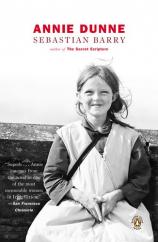Reading Group Guide
Discussion Questions
Annie Dunne

1. Looking at a crab-apple tree, with its "generous, bitter arms," Annie Dunne thinks "this is the happiness allowed to me" (p. 43). Why does Annie identify with the crab-apple? How does Sebastian Barry use the hills and trees of Kelsha to describe the people who live there, especially Annie?
2. "Poor Annie Dunne" (p. 20), the villagers say of Annie, referring to her once-influential family. How does Annie's sense of herself as fallen in social rank influence her relationship with her cousin? And with Billy Kerr?
3. "There is not much between the characters of Billy Kerr and Billy the pony" (p. 33), thinks Annie, and yet although we see Billy through Annie's eyes as a foolish lout, the events of the story suggest another side to him. How do Billy's actions—both kind and cruel—contrast with Annie's description of them?
4. Annie often refers to bones—her "old Kelsha bones" (p. 38), "the field sticks of my bones" (p. 40), her mother's "long set of bones" (p. 64). What does this reveal about Annie's sense of the essence of people?
5. "We are blessed in the company of these children," thinks Annie, "it is our chance" (p. 7), but Sarah describes the children as "shadows," into which she can't see (p. 77). How do Sarah and Annie relate to the children in different ways? Do the children come between them?
6. "The world of my youth is wiped away, as if it were only a stain on a more permanent fabric," thinks Annie. "I do not know where this Ireland is now" (p. 95). Annie Dunne is a novel about the loss of old ways, but by referring to past times as a place, how does Annie complicate conventional notions of nostalgia?
7. History looms behind Annie's memories, especially that of the revolutionaries who ended English rule in Annie's Ireland. Annie scorns them for having done so, but is her hatred political, or does it come from deeper, more personal emotions? What symbolic role do the historical figures Michael Collins and Eamon De Valera play in Annie's view of her own life?
8. What is the difference between Annie's relationship with her niece and with her nephew? How does the boy become a confidant of Annie's? Why does she describe him as "sean-aimseartha, an old fashioned child" (p. 119)?
9. How does Sarah's and Billy Kerr's "understanding" threaten Annie? Sarah and Annie are as close to each other as two people can be, but they see their relationship differently. What does Annie's "marriage of simple souls" (p. 127) mean to Sarah? What prompts her to put it at risk for Billy Kerr?
10. "You are surrounded by things you never notice," Annie's brother-in-law, Matt, tells her (p 156). Since we see the world through Annie's eyes—ever observant of the land and of Sarah, neglectful of changes in society—it is late in the book before the scope of her alienation from her surroundings emerges. Who is Annie in the eyes of those around her? What explains the great divide between Annie as she sees herself and the Annie whom others see?
Annie Dunne
- Publication Date: April 29, 2003
- Paperback: 256 pages
- Publisher: Penguin (Non-Classics)
- ISBN-10: 0142002879
- ISBN-13: 9780142002872








